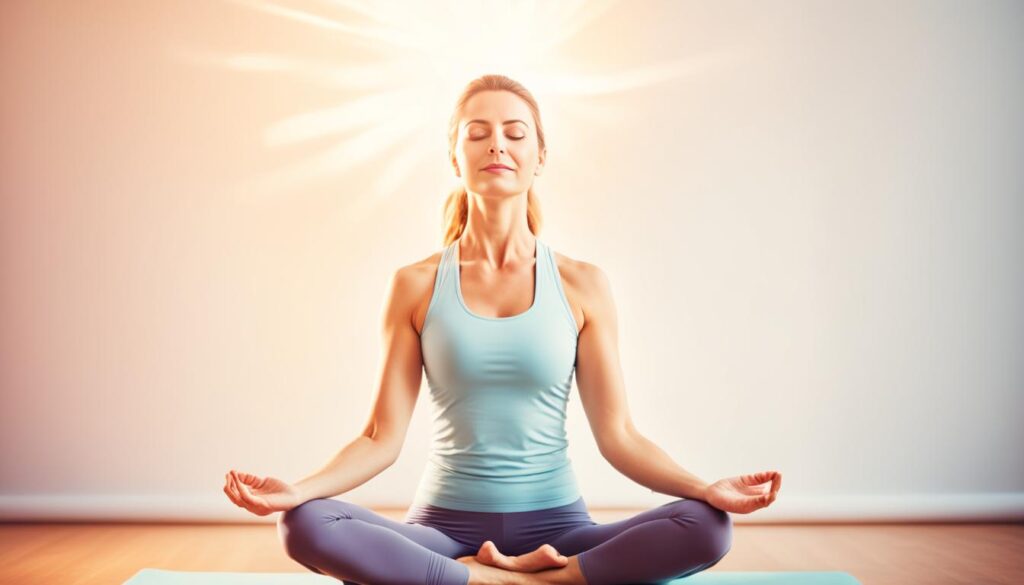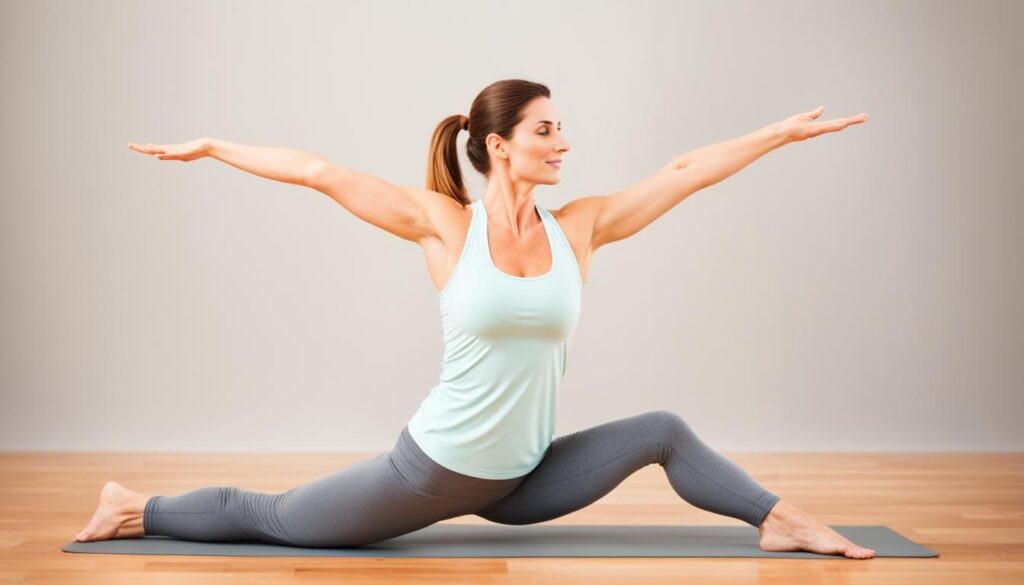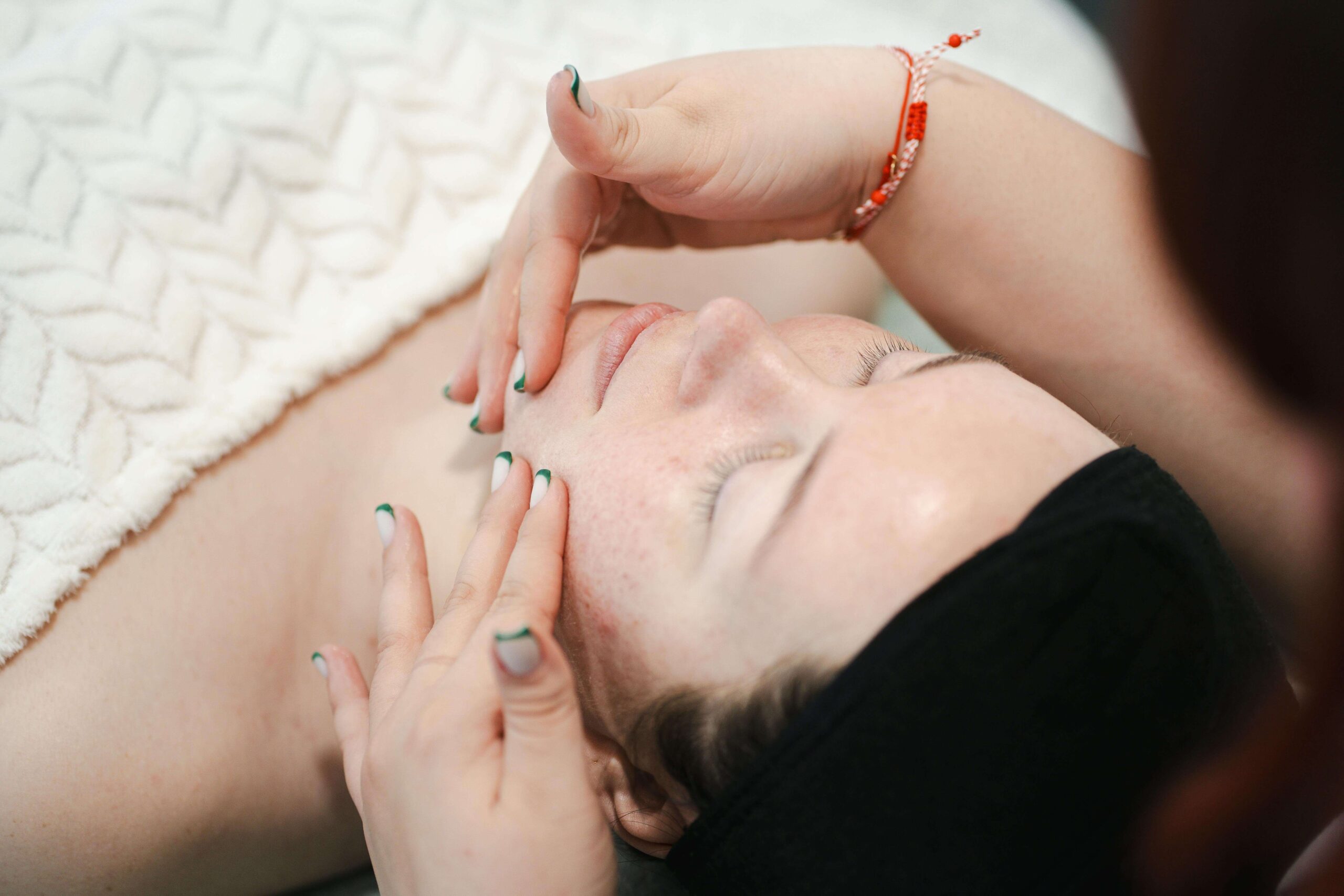Do you often feel back pain? You’re not the only one. Many Americans deal with back issues, like herniated discs or muscle tension. But, there’s hope – yoga can help. This guide will show you Yoga Poses for Back Pain, Restorative Yoga Sequences, and Spinal Decompression Asanas. These can ease your discomfort and improve your spinal health.
Table of Contents
ToggleKey Takeaways
- Discover gentle yoga poses and sequences that can alleviate back pain and improve spinal mobility.
- Learn about the common causes of back pain and how yoga can help address the underlying issues.
- Explore restorative yoga practices that promote spinal decompression and overall relaxation.
- Understand the benefits of incorporating core-strengthening poses into your routine for long-term back support.
- Gain insights on modifying yoga poses and using props to accommodate individual needs and comfort levels.
Introduction to Yoga for Back Pain Relief
Yoga is a great way to help with back pain. It uses the mind and body together for a full approach to relief. With Lower Back Stretches, Sciatica Yoga Poses, and Herniated Disc Yoga Therapy, yoga tackles both physical and emotional pain.
Yoga teaches mindfulness, breath control, and gentle movements. These help soothe the spine and muscles. By paying attention to how the body feels, people can find out why they have back pain. This helps them work on lasting solutions.
“Yoga’s focus on alignment, strength, and flexibility can be instrumental in managing and preventing back pain.”
If you have a herniated disc, sciatica, or chronic lower back pain, yoga can change things. By doing specific poses, controlling your breath, and meditating, you can ease tension. This improves mobility and helps balance your spine.
Next, we’ll look at different Lower Back Stretches, Sciatica Yoga Poses, and Herniated Disc Yoga Therapy that can help. By learning about back pain causes and yoga benefits, you can take charge of your health. This leads to a life with less pain and more comfort.
Causes of Back Pain and How Yoga Can Help
Dealing with back pain can be tough and really slow you down. Luckily, yoga is a natural way to tackle this issue. It helps by addressing the main causes of back pain and improving spinal health.
Understanding Common Back Conditions
Back pain can come from many things like bad posture, injuries, or health issues. Common problems include herniated discs, bulging discs, and sciatica. These can cause sharp pains and make moving harder.
Benefits of Yoga for Back Pain Management
- Improved flexibility and range of motion in the spine
- Core strengthening poses to support the back and alleviate pressure
- Spinal decompression through gentle, restorative postures
- Stress reduction and relaxation, which can aid in pain management
Adding Yoga for Bulging Discs and other specific yoga practices can really help. It strengthens, stretches, and helps you breathe better. This can bring back balance and ease the pain.
“Yoga has been a game-changer for my back pain. The poses and breathing exercises have helped me regain flexibility, build core strength, and manage my discomfort without relying on medication.”
– Sarah, a yoga practitioner with a history of back pain
Yoga Poses for Back Pain
Using yoga poses for back pain can help ease discomfort and improve health. These poses focus on different back areas, like the lower and upper back, and shoulders. Practicing these back pain relief exercises can make you more flexible, strong, and improve your spine health.
The Child’s Pose is a key pose for back pain relief. It stretches the lower back and helps you relax. Start on your hands and knees, then sit back on your heels with your arms out in front. Breathe deeply and stay in the pose for a few minutes.
- The Sphinx Pose is great for the lower back. Lie on your stomach with elbows under your shoulders. Lift your chest off the floor to open up the front of your body.
- For the mid and upper back, try the Cat-Cow Pose. Start on your hands and knees. Arch and round your back, moving with your breath.
- The Downward-Facing Dog helps various back areas. Begin in a standing forward fold. Then, press your hands down and lift your hips up and back, forming an “V” shape.
Adding these yoga poses for back pain to your routine can change your life. It helps you find relief and boosts your spinal health. Always listen to your body and adjust poses to keep your practice safe and comfy.
| Yoga Pose | Benefits |
|---|---|
| Child’s Pose | Stretches the lower back, promotes relaxation |
| Sphinx Pose | Targets the lower back, opens the front of the body |
| Cat-Cow Pose | Mobilizes the mid and upper back, improves flexibility |
| Downward-Facing Dog | Provides relief for various areas of the back, strengthens the core |
“Yoga is not just about the physical postures. It’s a way of moving into stillness to acknowledge our wholeness.” – Judith Hanson Lasater
Gentle Warm-up Poses
Getting your body ready for deeper yoga is key. Start with gentle poses and breathing to boost blood flow and make your joints more flexible. These Restorative Yoga Sequences and Spinal Decompression Asanas ease you into deeper stretches and backbends.
Preparatory Stretches and Breathing Exercises
Start with simple yet powerful warm-up moves. Cat-Cow Pose stretches and bends your spine. Child’s Pose stretches your back and relaxes your shoulders. Don’t forget the Supine Twist to ease tension in your lower back and hips.
- Cat-Cow Pose
- Child’s Pose
- Supine Twist
Combine these stretches with deep, focused breathing to get your body and mind ready. Diaphragmatic Breathing is great for calming your nerves and helping your spine move freely.

“Patience and gentle persistence are key when it comes to relieving back pain through yoga. Allow your body to gradually open up and trust the process.”
These gentle poses help your body relax and get ready for yoga. Take your time, breathe deeply, and let go of tension. With regular practice, you’ll see better movement and less back pain.
Lower Back Stretches and Poses
If you’re looking for relief from lower back pain, try adding specific yoga poses to your routine. These Lower Back Stretches and Sciatica Yoga Poses can ease pain, strengthen your core, and boost spinal health.
Targeted Asanas for Lumbar Relief
The Cat-Cow Pose is great for easing lower back pain. It helps move the spine, easing tension and boosting flexibility. Start on all fours, arch your back (Cat Pose), then drop your belly towards the floor (Cow Pose), moving with your breath.
The Downward-Facing Dog pose is also helpful. It stretches the spine, strengthens shoulders and arms, and relieves lower back tension. Press your palms down, lift your hips, and stretch your spine, feeling the stretch in your lower back and hamstrings.
The Triangle Pose is perfect for easing lower back pain. It opens up the side body, easing tension and improving flexibility. Stand with your feet wide, turn one foot out, and stretch your arms up, reaching for the sky as you lower your hips.
Adding these yoga poses to your routine can help relieve lower back pain. They can make you feel better. Always listen to your body and adjust poses as needed for a safe practice.
Mid and Upper Back Poses
Yoga is great for easing back pain, especially in the mid and upper back. These poses help release tension in the shoulders and improve the mobility of the thoracic spine. They also help keep the spine aligned. Let’s look at some Yoga Poses for Back Pain that can help with relief in the middle and upper back.
Shoulder-Opening Poses
- Cow Face Pose (Gomukhasana): This pose opens the shoulders and chest, releasing tension in the upper back.
- Reverse Warrior (Viparita Virabhadrasana): This pose stretches the side body and shoulders, providing a gentle backbend.
- Thread the Needle (Parsva Balasana): This pose targets the upper back and shoulders, helping to release tightness.
Thoracic Mobility Exercises
- Cat-Cow Pose (Marjaryasana-Bitilasana): This flowing sequence promotes spinal flexibility and awareness.
- Twisting Poses (Parivrtta Asanas): Gentle twists, such as Revolved Chair Pose, can help improve thoracic mobility.
- Backbends (Urdhva Mukha Asanas): Mild backbends, like Upward Facing Dog, can open the chest and upper back.
Adding these Yoga Poses for Back Pain and Back Pain Relief Exercises to your routine can improve mobility and reduce tension. It can also help with spinal health in the mid and upper back. Always listen to your body and adjust the poses as needed to find the right balance.
Restorative Yoga Sequences
Life can be tough on our bodies, especially our spines. That’s why restorative yoga is here to help. It’s a practice that deeply relaxes the body and mind. It also gives gentle traction and decompression to the spine. These Restorative Yoga Sequences and Spinal Decompression Asanas offer a peaceful break from daily stress.
Soothing Postures for Spinal Decompression
Restorative yoga is great for decompressing the spine. It relieves pressure and tension in the back. With supported backbends, gentle twists, and relaxing forward folds, it gently stretches the spine. This lets the vertebrae align naturally.
Some top Spinal Decompression Asanas are:
- Supported Reclined Butterfly Pose (Supta Baddha Konasana)
- Restorative Child’s Pose (Balasana)
- Legs-Up-the-Wall Pose (Viparita Karani)
- Supported Supine Twist (Supta Matsyendrasana)
These poses use props like blankets, blocks, and bolsters. They let the body fully relax and release. This promotes deep relaxation and rejuvenation.
Adding these Restorative Yoga Sequences to your routine can bring many benefits. You’ll see better posture, less pain, and overall well-being.
“The body is not a prison, but a temple – and it is our job to keep it well-maintained and cared for through practices like restorative yoga.”
| Pose | Benefits | Props Needed |
|---|---|---|
| Supported Reclined Butterfly Pose | Releases tension in the lower back, hips, and groin | Blankets, blocks, bolster |
| Restorative Child’s Pose | Gently stretches the spine and allows the back to decompress | Blankets, blocks |
| Legs-Up-the-Wall Pose | Provides traction for the spine and relieves pressure on the lower back | Blankets, wall |
| Supported Supine Twist | Decompresses the spine and promotes spinal mobility | Blankets, blocks |
Core Strengthening Poses
Core strengthening poses in yoga are key to easing back pain. A strong core supports the spine, easing back strain and improving posture. These yoga poses help build core strength and ease back pain.
The Plank Pose is a key pose for core strength. It works the abs, shoulders, and legs, helping to stabilize the spine. To do the Plank Pose, start in a push-up position, keeping your body straight from head to heels, and engage your core.
The Side Plank Pose targets the obliques, important for spine stability and rotation. To perform the Side Plank Pose, start side-lying, stack your feet, and lift your hips off the mat, using one forearm for support.
The Boat Pose is a challenging pose that strengthens the core. To do the Boat Pose, sit with knees bent and feet on the mat, lean back, and lift your feet off the floor. Balance on your sit bones and engage your core.
Adding these poses to your yoga routine builds a strong spine foundation. This helps ease back pain and boosts overall health.

“A strong core is the key to a healthy back and improved posture. Consistent practice of these core strengthening poses can make a significant difference in managing back pain.”
| Pose | Benefits | How to Perform |
|---|---|---|
| Plank Pose | Strengthens the abdominal muscles, shoulders, and legs | Start in a push-up position, keeping your body in a straight line from head to heels and your core engaged. |
| Side Plank Pose | Targets the oblique muscles for lateral stability and spine rotation | Start in a side-lying position, stacking your feet and engaging your core to lift your hips off the mat, supporting your weight on one forearm. |
| Boat Pose | Challenges the core muscles for balance and stability | Sit with your knees bent and feet on the mat, then lean back and lift your feet off the floor, balancing on your sit bones and engaging your core muscles. |
Yoga Poses for Sciatica and Herniated Discs
Dealing with sciatica or a herniated disc can be tough. But, yoga can help. It’s a gentle way to ease nerve pain and help heal. By doing certain yoga poses, you can take charge of your recovery.
Gentle Movements for Nerve Pain Relief
When you have sciatica or a herniated disc, yoga should be gentle and mindful. Soft movements can lessen inflammation, increase flexibility, and ease nerve pressure. Here are some yoga poses that can help:
- Reclined Pigeon Pose (Supta Kapotasana) – This pose stretches the piriformis muscle, which can ease sciatic nerve pain.
- Child’s Pose (Balasana) – A simple forward fold that can help decompress the spine and relieve sciatica and herniated discs.
- Supine Twist (Jathara Parivartanasana) – A twist that releases tension in the lower back and hips, reducing nerve irritation.
Always listen to your body and adjust the poses to stay comfortable and safe. Doing these gentle yoga poses regularly can help manage sciatica and herniated discs symptoms. This can lead you towards recovery.
| Yoga Pose | Benefits for Sciatica and Herniated Discs |
|---|---|
| Reclined Pigeon Pose (Supta Kapotasana) | Stretches the piriformis muscle, which can help alleviate sciatic nerve pain. |
| Child’s Pose (Balasana) | Decompresses the spine and provides relief for both sciatica and herniated discs. |
| Supine Twist (Jathara Parivartanasana) | Releases tension in the lower back and hips, easing nerve irritation. |
“Yoga is not just about the physical poses, but about finding inner peace and balance. By incorporating gentle, mindful movements, you can take an active role in managing your back pain and reclaiming your health.”
Yoga for Bulging Discs
If you’re dealing with the discomfort of bulging discs, yoga can help. Certain yoga poses and sequences are made to gently decompress the spine. They also reduce inflammation and support the health of the intervertebral discs.
Spinal Decompression Asanas
Yoga is great for bulging discs because it creates space between the vertebrae. This relieves pressure on the discs. Poses like Downward-Facing Dog, Child’s Pose, and Cat-Cow stretch and decompress the spine.
- Downward-Facing Dog: This inversion pose stretches the back and elongates the spine.
- Child’s Pose: A restorative pose that releases tension in the lower back and encourages spinal decompression.
- Cat-Cow: This gentle flow moves the spine through flexion and extension, promoting mobility and circulation.
Adding these Yoga for Bulging Discs poses to your routine can ease discomfort. It also supports your spine’s health.
Strengthening the Core
Building core strength is key for managing bulging discs. Poses like Plank, Boat Pose, and Locust Pose help stabilize the spine. They take pressure off the discs.
| Pose | Benefits |
|---|---|
| Plank | Strengthens the core, stabilizes the spine |
| Boat Pose | Engages the abdominal muscles, improves balance |
| Locust Pose | Strengthens the back and glutes, improves posture |
By adding these Spinal Decompression Asanas and core-strengthening poses to your yoga, you can ease bulging disc discomfort. You’ll also support your spine’s health.
Modifications and Props for Back Pain
Yoga can help with back pain, but it’s key to adjust poses and use props for comfort and safety. By changing yoga poses and using support tools, people with back pain can feel more at ease. This makes their practice better.
Adapting Poses for Optimal Comfort
For Back Pain Relief Exercises, listen to your body and adjust as needed. Here are tips for changing yoga poses for your needs:
- Use blocks, straps, or blankets to support and elevate different parts of the body, reducing strain on the back.
- Try seated or reclined versions of poses to ease pressure on the spine.
- Modify forward folds by bending the knees or using a strap around the thighs to prevent overstretching.
- Add gentle backbends and side-bends to help with the effects of sitting too much or poor posture.
These simple changes let you do Restorative Yoga Sequences safely. They help nourish and heal your back without causing more harm.
| Yoga Prop | How it Helps with Back Pain |
|---|---|
| Blocks | Support the hands, feet, or other parts to lessen back strain. |
| Straps | Help you deepen stretches and poses safely without straining the back. |
| Blankets | Used for padding, support, or to lift the hips or legs in restorative poses. |
Adding these changes and props to your yoga can make Back Pain Relief Exercises and Restorative Yoga Sequences more enjoyable. It keeps your comfort and safety in mind.
Conclusion
This guide has shown how yoga can help with back pain. We’ve looked at why back pain happens and how yoga can help. Now, readers know how to add yoga to their daily routine.
We’ve shared gentle poses, stretches, and exercises to help with back pain. These include sciatica, herniated discs, and bulging discs. By doing these Yoga Poses for Back Pain regularly, people can feel less pain, move better, and feel better overall.
Starting your yoga journey to ease back pain? We suggest finding a qualified yoga teacher or doctor. They can give you personalized advice and make sure the Back Pain Relief Exercises are right for you. With yoga, you can overcome back pain and live a healthier, happier life.
FAQ
What are the benefits of yoga for back pain relief?
Yoga is great for easing back pain. It combines physical postures, breathing exercises, and meditation. These can improve flexibility, strengthen the core, and help with spinal health.
What are some of the common causes of back pain that yoga can address?
Yoga helps with back pain from poor posture, injury, and conditions like herniated discs. It targets specific muscles and improves spinal mobility. This can ease physical and emotional pain.
What are some of the best yoga poses and sequences for back pain relief?
Certain yoga poses and sequences help with back pain. These include stretches, lower back asanas, and poses for the mid and upper back. Restorative poses also help with spinal decompression. Always work with a qualified instructor for proper alignment and modifications.
How can I modify yoga poses to accommodate my back pain?
Using props like blocks, straps, and blankets helps adapt yoga poses for back pain. Your instructor can show you how to modify poses safely and effectively for your needs.
Are there any yoga poses or sequences I should avoid if I have back pain?
Avoid poses that involve deep backbends, twists, or sudden movements if you have back conditions like herniated discs. Always check with your instructor or healthcare provider to find poses that are safe for you.
How often should I practice yoga for back pain relief?
How often you should practice yoga depends on your back condition and needs. Experts suggest gentle yoga daily or a few times a week for flexibility and strength. Intensive sequences may be best a few times a week, with rest days in between. Listen to your body and consult with your instructor or healthcare provider for the best schedule.
Can yoga help with sciatica and herniated discs?
Yes, yoga can help with sciatica and herniated discs. Gentle poses and sequences can ease nerve pain, reduce inflammation, and aid healing. Always work with a qualified instructor or healthcare provider to choose the right poses for your condition.
How can yoga help with bulging discs?
Yoga poses focused on spinal decompression can help with bulging discs. These movements reduce pressure on the discs, decrease inflammation, and support spine health. Always consult with a qualified instructor or healthcare provider for the best practices for your needs.









